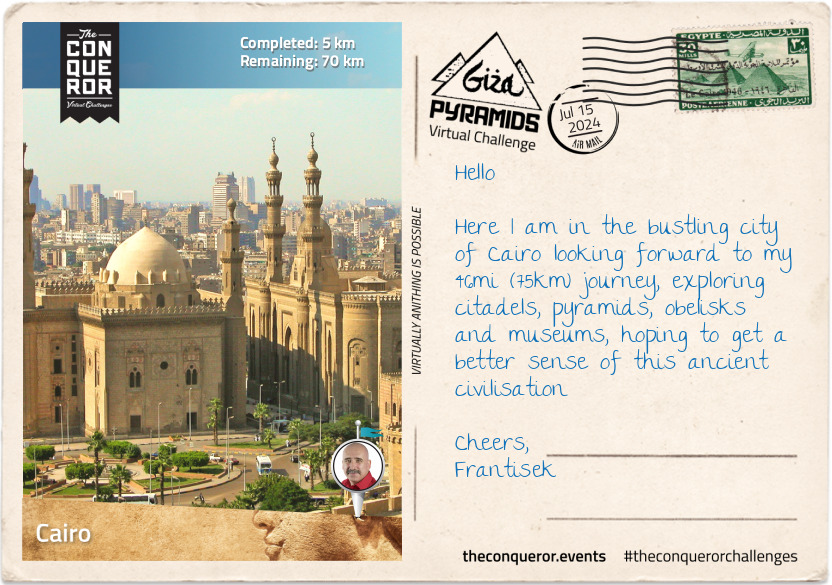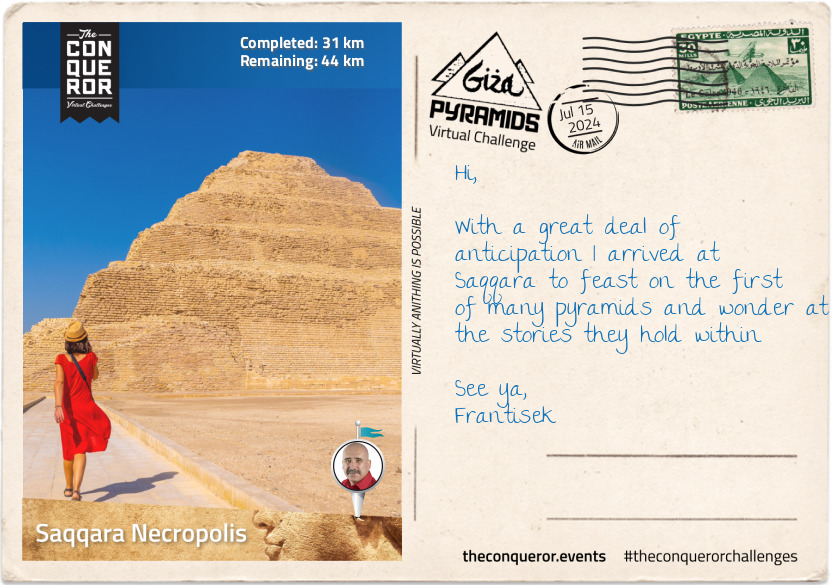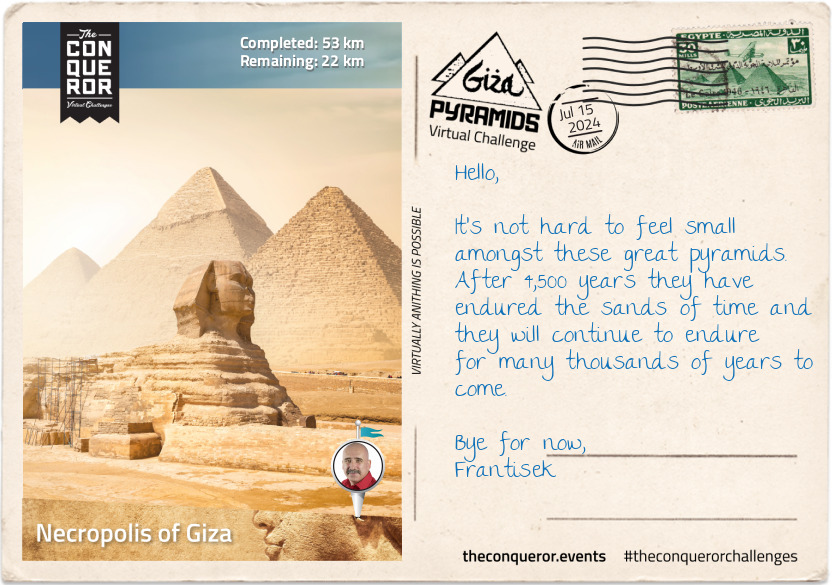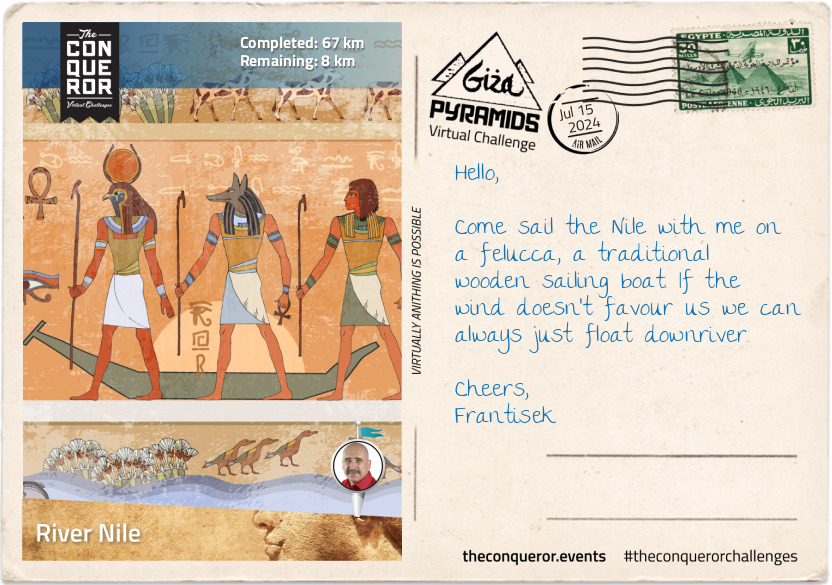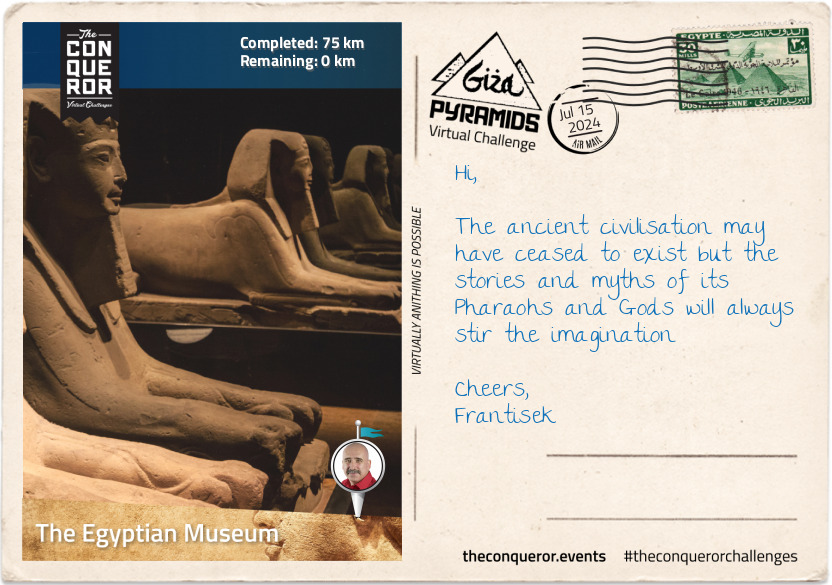km od začátku : 0075
River Nile
The Nile River is the longest river in the world, although some Brazilian scientists are currently claiming that the Amazon River is longer. It is 4,132mi (6,650km) long and travels through or on the border of ten African countries. It begins in the rivers that flow into Lake Victoria, north of Tanzania and flows northwards, draining into the Mediterranean Sea. It has two tributaries: the White Nile from Central Africa, considered as the primary stream and the Blue Nile from Ethiopia, considered as the main source of water up to 80% and silt.
There were more than 175 pharaohs, 2,000 deities and over 100 pyramids during Ancient Egypt's long history. Many tombs and pyramids have since been ransacked by thieves and for a long time, there was no protection or preservation of Egyptian antiquities. Egyptian curiosity began with Napoleon Bonaparte's campaign into Egypt between 1798-1801. He took a group of scholars and scientists with him to learn all they could about Egypt. What followed was a series of publications distributed within France over a period of 20 years. All of the works, research, notes and illustrations were eventually compiled into the Imperial Edition consisting of 23 books entitled "Description de l'Égypte" (Describing of Egypt).
Prior to legislation, many antiquities were removed from Egypt to join private collections or museums around the world. A decree was issued in 1835 by the then governor of Egypt, Mohamed Ali Pasha, prohibiting any export or trade of Egyptian antiquities.
The Egyptian Museum, where this journey ends, was born out of an international competition in 1895 and won by French architect Marcel Dourgnon. It houses 160,000 artifacts ranging from the pre-Dynasty period all the way through to the Roman era.
The Museum holds some very important pieces, such as the Palette of Narmer, which depicts the unification of Upper and Lower Egypt under one King. The palette is so significant that it has never been allowed to leave the country on any touring exhibitions.
Some of the earliest hieroglyphic inscriptions were found on the palette. Hieroglyphs were the formal writing system often used in tombs, monuments and religious texts. They were stylized pictures of objects representing a word, syllable or sound. For everyday purposes, the writing style was hieratic script, which was a faster version of hieroglyphs, and then it was further simplified via demotic script to write legal documents. However, once they were conquered by Alexander the Great, scribes had to write in Greek and over time, the meaning of the hieroglyphs was lost. No one understood it anymore until the Rosetta Stone was found in 1799. On the stone was a decree in two languages and three writing styles: hieroglyphic, demotic and Ancient Greek. Over the next 23 years, scholars would build upon each other's deciphering works until 1822, when French scholar Jean-Francois Champollion cracked the code. Ancient Greek was widely known by scholars, and it was used as a way to work backwards till the code was finally deciphered.
Statues of the three kings who built the Giza pyramids are also within this museum's collection. As big as the Great Pyramid is, Khufu's statue is quite small, all of 3in (7.5cm), but it is the only three-dimensional image of him.
Walls are lined with coffins that once held mummified bodies. Mummification was a complex process that took 70 days to complete—starting by removing the brain through the nose and then removing the organs, which, after they dried, were stored in canopic jars. The heart was left inside as it was thought to be the seat of the soul. Interestingly, it was believed the brain was useless and hence thrown away because they thought the heart was the centre of thought and personality. The body was rinsed, packed with natron (salt), covered with more natron then left for several weeks to dehydrate the body. The next phase was to wash, oil, and cover it with resin as an adhesive. Wrapping it completely in linen, it was then placed in a mummy-shaped coffin that was quite often intricately designed. Depending on the status of the deceased, the mummy may have also been covered with a mask such as the one found on King Tutankhamun. Protective amulets were included in the coffin, then sealed, and the coffin was then inserted into a stone sarcophagus.
The most elaborate burial was that of King Tut. His mummy was inside several layers of the container. There were three coffins each inside the other (like Babushka dolls), with the innermost coffin made entirely out of solid gold. The coffins lay inside a stone sarcophagus that rested inside four box-like shrines, each gilded and heavily decorated inside with spells from the Book of the Dead.
Tutankhamun may have been only 19 when he died but he was instrumental in restoring the old gods which were banished by his father, Akhenaten, who only wanted to have one god for the royal court. All sorts of deities were worshipped by the Egyptians, but the most powerful god was the sun god, Ra, who travelled across the sky in his sun boat, bringing warmth and light to the people.
One of the most influential stories in ancient Egyptian mythology was that of two brothers, Osiris (god of the underworld and afterlife) and Set (god of chaos). Osiris was once a Pharaoh and married to Isis (goddess of life and magic). Together, they had a son, Horus. Set wanted the throne and to rule Egypt. He tricked Osiris into climbing into a chest, which he then sealed shut and tossed down the Nile. Isis went searching for Osiris, and when she found him, he was already dead. She resurrected Osiris, but he was neither dead nor alive, thereby forcing him to retreat to the underworld and become the king of the dead. Once Horus was fully grown, he set out to avenge his father and claim the throne. A battle ensued in which Horus lost his left eye but won the battle, vanquishing Set. The eye became known as the "Eye of Horus", symbolising protection, royal power and good health.
Other famous pharaohs and queens who left their mark were:
- Hatshepsut – she ruled for 20 years, supposedly on behalf of her stepson, but eventually declared herself a Pharaoh and even started wearing a beard, which was a sign of royalty. She was a great ruler who re-established trade routes and maintained an extended period of peace.
- Akhenaten – was the father of Tutankhamun, who abolished all the gods, closed all the temples and decreed only one sun god, Aten.
- Nefertiti – was the wife of Akhenaten and a strong influence supporting monotheism. Her bust is widely recognised with her tall cap crown and widely contested as to who owns it.
- Ramesses II – he reigned for 67 years and had 96 children. He built a huge number of monuments and temples that nearly bankrupted the throne and unabashedly declared himself a god.
- Cleopatra – she was the last active ruler of Egypt. Politically savvy, she brought peace and prosperity to the people. When she heard that her lover, Marc Antony, was dead, she took her own life. With her death, the Egyptian empire came to an end.
Deep within its sands, both Saqqara and Giza Necropolis hold many more secrets yet to be uncovered. Ancient Egypt was an extraordinary civilisation. It was able to adapt to the conditions of the Nile River, build pyramids and other great works with great precision and had to invent many things for itself, like writing, mathematics, metallurgy, paper (the papyrus) and anything else they needed to function as a society. They laid the foundations for many things that were improved upon by later civilisations.














